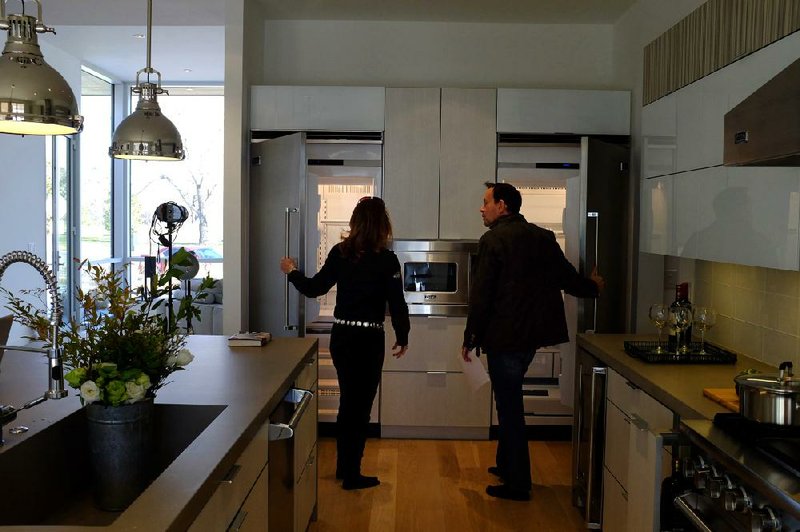The number of Americans who signed contracts to buy existing homes in November remained essentially unchanged from October, suggesting sales are stabilizing after several months of declines.
The National Association of Realtors said Monday that its seasonally adjusted pending home-sales index ticked up to 101.7 from 101.5 in October. The October figure was revised lower from an initial reading of 102.1.
Higher mortgage rates and strong price gains during the past two years have slowed sales. The pending home-sales index had fallen for five straight months before November. And completed sales of existing homes fell for three straight months, the Realtors Association said earlier this month.
There is generally a one-to two-month lag between a signed contract and a completed sale.
In addition to higher mortgage rates, tight lending standards and price increases driven by a limited supply of homes for sale are discouraging some prospective buyers, according to some analysts. Further gains in hiring, household wealth and consumer confidence would help boost the housing recovery and give greater momentum to the economy.
“Next year, we think housing is going to continue to grow at a fairly solid pace,” said Daniel Silver, an economist at JPMorgan Chase & Co. in New York. “You have a story of things getting better in the economy, better job growth, driving the numbers.”
The pending sales index was 101.7 on a seasonally adjusted basis. A reading of 100 corresponds to the average level of contract activity in 2001, or “historically healthy”home-buying traffic, according to the Realtors group.
The median projection in a Bloomberg News survey of 30 economists called for a 1 percent advance. Estimates in the survey ranged from a decline of 1 percent to an advance of 5 percent.
Purchases dropped 4 percent from the year prior on an unadjusted basis after a 2.7 percent decrease in the 12 months that ended in October, the Realtors’ Association reported.
Economists consider pending-home sales a leading indicator because they track contract signings. Existing-home sales are tabulated when a contract closes, usually a month or two later.
Purchases of previously owned homes dropped 4.3 percent to a 4.9 million annual rate in November, the lowest level of the year, the National Association of Realtors reported earlier this month.
Despite the recent declines, home resales should reach 5.1 million in 2013, the best total in seven years, the Realtors forecast. That’s 10 percent higher than 2012’s total of almost 4.7 million. But it’s still below the 5.5 million that is consistent with a healthy housing market.
The Realtors’ report predicts sales will remain largely flat in 2014 and then will rise to 5.3 million in 2015. Steady job gains should make it easier for more people to buy homes. And mortgage rates remain low by historical standards.
Two of the four regions showed a decrease from October, with pending home sales in the Northeast dropping 2.7 percent and the Midwest falling 3.1 percent. Pending sales rose 2.3 percent in the South and 1.8 percent in the West.
Robert Kavcic, an economist at BMO Capital Markets, said that recent housing-market indicators have been mixed. Applications for mortgages to purchase homes fell to a nearly two-year low last week, he said.
Still, “we continue to believe that the U.S. housing market will absorb the upward move in mortgage rates and push higher in 2014, helped by still attractive affordability, better job growth and improved confidence in the recovery,” Kavcic said.
The average interest rate on a 30-year mortgage edged higher to 4.48 percent last week, from 4.47 percent the previous week. Rates jumped about 1.25 percentage points from May through September, peaking at 4.6 percent. That increase occurred after Federal Reserve Chairman Ben Bernanke indicated that the Fed would start to slow its bond buying program before the end of the year.
Earlier this month, the Fed announced it will reduce its $85 billion in monthly bond purchases by $10 billion a month starting in January. The bond purchases are intended to push down longer-term interest rates and encourage more borrowing and spending.
“We may have reached a cyclical low because the positive fundamentals of job creation and household formation are likely to foster a fairly stable level of contract activity in 2014,” National Association of Realtors Chief Economist Lawrence Yun said in a statement.
The S&P/Case-Shiller national home-price gauge rose 11.2 percent in the third quarter from the same period in 2012, the biggest year-over-year advance since the first three months of 2006. Its index of property prices in 20 U.S. cities, set for release today, probably increased 13.5 percent in October from a year earlier, said a Bloomberg survey.
After two years of rapidfire growth, the housing market shows signs of returning to normal, said Budge Huskey, president and chief executive officer of Coldwell Banker LLC, a real-estate services firm in Madison, N.J.
Information for this report was contributed by Christopher S. Rugaber of the Associated Press and by Lorraine Woellert, Chris Middleton, Michelle Jamrisko and Jeanna Smialek, all of Bloomberg News.
Business, Pages 21 on 12/31/2013

